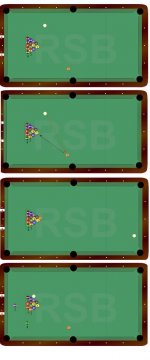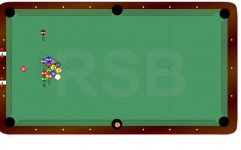Since I’ve shown favoritism to the nine-ballers in recent “what would you do here?” threads, it’s time to bring the straight pool geeks (and I’m certainly one of those) back into the mix.
I’m going to deviate from my usual format, and just tell you what happened in a famous match. Then, you’ll be asked to consider whether a good decision was made by the player. Setting the scene, the match took place in 1979 (I think, but I’m not that sure) and the players were Irving Crane and Joe Balsis, two of the all-time greats and two BCA Hall of Fame members.
The score was about 120 – 110 in Irving’s favor in the race to 150, and tight equipment was in use. Crane badly misplayed the shape on the previous rack’s final ball, and in the first table below, you will find the position he faced. He was dead straight on the five in the side, but it was possible to cheat the pocket and draw into the pack. In the second table you’ll find that shot, the one I thought he’d play, with a safety or intentional foul next if he didn’t break the balls. In the third table shown below, you’ll find a safety, involving pocketing the five, that I thought he might consider, with the resulting layout taking the spotted five ball into account. In the fourth table, you’ll find the shot Crane actually played, a shot we all have played many times, but one that I think left Balsis quite astonished.
Irving was a good friend of mine and I thought I knew his game pretty well, but this choice absolutely shocked me. I asked him what the reasoning behind the shot was when the match ended. After I hear from the forum about the advisability of Irving’s shot, I’ll share what Irving said to me. Also, does anyone care to guess what Joe Balsis tried from the resulting position in table four?
I’m going to deviate from my usual format, and just tell you what happened in a famous match. Then, you’ll be asked to consider whether a good decision was made by the player. Setting the scene, the match took place in 1979 (I think, but I’m not that sure) and the players were Irving Crane and Joe Balsis, two of the all-time greats and two BCA Hall of Fame members.
The score was about 120 – 110 in Irving’s favor in the race to 150, and tight equipment was in use. Crane badly misplayed the shape on the previous rack’s final ball, and in the first table below, you will find the position he faced. He was dead straight on the five in the side, but it was possible to cheat the pocket and draw into the pack. In the second table you’ll find that shot, the one I thought he’d play, with a safety or intentional foul next if he didn’t break the balls. In the third table shown below, you’ll find a safety, involving pocketing the five, that I thought he might consider, with the resulting layout taking the spotted five ball into account. In the fourth table, you’ll find the shot Crane actually played, a shot we all have played many times, but one that I think left Balsis quite astonished.
Irving was a good friend of mine and I thought I knew his game pretty well, but this choice absolutely shocked me. I asked him what the reasoning behind the shot was when the match ended. After I hear from the forum about the advisability of Irving’s shot, I’ll share what Irving said to me. Also, does anyone care to guess what Joe Balsis tried from the resulting position in table four?

